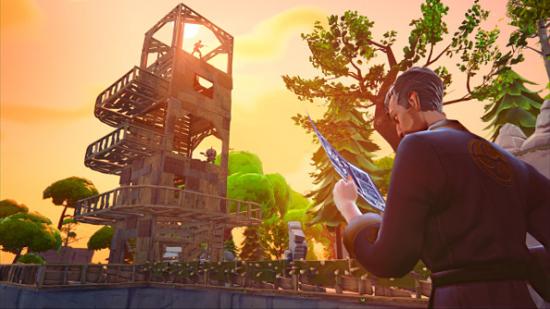When I was a kid, I dug a slit trench in my backyard, right next to the woodpile. It went swimmingly until I hit the dense clay that lies in patches beneath two or three feet of Indiana topsoil. Then, unable to go deeper, I decided to start digging out farther, using the loose dirt to created a kind of a breastwork.
Either way, my father eventually came outside and discovered his son jamming pointy sticks into an earthen berm, with a replica bolt-action rifle slung over his shoulder. He wasn’t even angry, I don’t think. Just amazed at the curious industry I’d shown.
I loved the idea of digging-in, of fortifying myself against… something. I imagined hordes of the Hun wasting themselves against my defenses as my imaginary platoon and I cut them down like the cordwood that held my left flank on that warm spring day.
For me, Epic Games’ Fortnite is all about that day. It’s about sneaking into the garage to steal some tools, and then getting to work building something that’s equal parts absurd and murderous. Except you can build something better, and it’s easier to get friends to help.
The setup for Fortnite is that the the world has been plunged into chaos by the arrival of a strange storm. In each mission, you and a team of other players liberate each region by activating a special transmitter that causes the storm to recede.
But before it does, the storm warps in waves of monsters to try and smash through your defenses and destroy the transmitter. You and your team, having built your fort, now have to defend it with rifles, machine guns, swords, and whatever else comes to hand.
If I had to come up with a comparison for Fortnite, I’d say it’s a combination of Orcs Must Die and Gears of War, except that you kind of have to build your own level. Whatever you construct before the battle commences, that’s going to give the ensuing combat its shape.
To get the job done, there are three classes in the game right now. There’s the builder (engineer) class, soldier (commando) class, and the melee (ninja) class. Now, everyone can build whatever they want in the game and use whatever weapon they choose, but each class just happens to be a little better at it. The engineer builds faster and, after buying some skills with experience points, also tends to build more durably. The soldier does better with guns and explosives than the other classes, while the ninja is not only better with melee weapons, but also has a lot of stuns and escape powers to let them survive in a big scrum.
There are also extensive plans for multiplayer and a persistent online feature where players gather resources to invest in their own personal fortress. Not only does this fort provide additional bonuses (for instance, if you have a weapons lab, you might be able to bring a special piece of combat gear into missions), but it can also be a tower defense sandbox where you can try to build an impregnable citadel… and then defend it in a horde mode against endless waves of enemies.
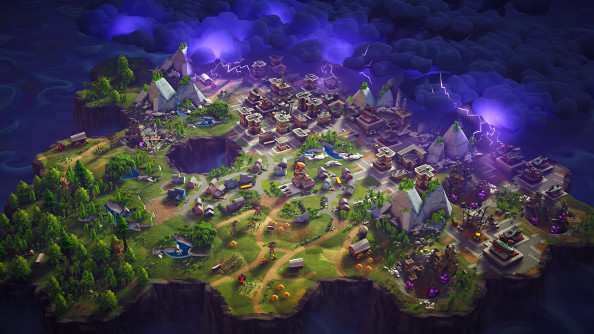
A strong foundation
Fortnite could be broadly divided into three phases: the gathering phase, the construction phase, and the combat phase. Different missions might mix up the order a bit, and they have a way of bleeding into one another, but this basically the beginning, middle, and end of a Fortnite mission.
When you’re out wandering the world on your way to a mission objective, almost everything in Fortnite’s Far Side-meets-Pixar world can be smashed into pieces and used for parts. Wood is the most plentiful, then stone, and then metal. There are also special components, like mechanical parts, that are used for crafting advanced tools and equipment like traps and guns.
Fortnite wasn’t always so cheery. Lead designer Darren Sugg talked about earlier versions of the game where players were kept on the brink of death, and the world itself was a more typical apocalypse.
“With our evolution, it was more grim initially,” he said. “The art style changed, the gameplay changed. We wanted to have some whimsical moments in the game. We wanted to make it the kind of game where you could attach a rocket engine to a hammer and use that as a weapon…. So the style changed.”
To keep players from stripping the land bare and trying to craft everything they possibly can right away (which would get pretty boring), each mission takes place on a timer. The faster you move through a mission, the better a score you get on it. But you do need those resources, which means you have to balance mission progress against gathering. It’s especially fraught because not every zone is created equal. Wilderness zones have lots of wood and stone, but not much in the way of mechanical parts. Towns and cities have lots of metal and machines, but not a lot of trees and boulders.
The thing is, you have to craft absolutely everything in this game. Your pickaxe for mining resources is a craftable item. So is your gun. So is your sentry turret, to say nothing of the walls and ramparts you need to build for your defense. If you start running short of critical resources on a hard mission, you can find yourself in very deep trouble. So waste not, want not.
Of all the phases, though, construction was my favorite. It’s all imagination and collaboration. You and your team try to identify the likely attack angles, then start constructing the obstacles you need to keep the enemy at bay. For the most important areas, reinforced metal is the most durable material and will take the longest for the monsters to wear down. Stone is a good second-tier alternative, and wood is useful for areas where you don’t expect much trouble… or for little shooting platforms to use during combat. A metal wall will stack up enemies as they try to claw through, and a wooden catwalk above them can let one player rake them with fire from one position.
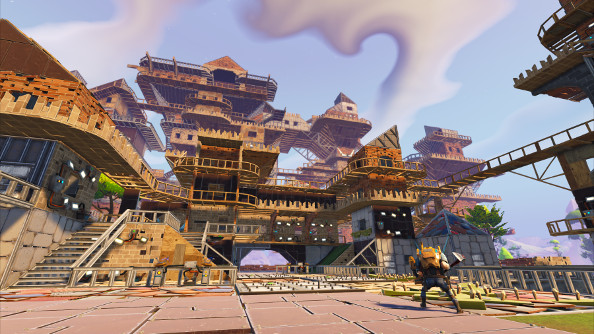
The physics are entirely cartoon. There are no load-bearing walls. The only rule is that you have to to be able to trace a path to the ground from each piece you lay down. So if you can have an entire fort floating in the air connected to a single staircase… but if that staircase gets cut, the entire fort comes down immediately.
Not everyone is going to be on the same page, and something about Fortnite’s cartoony physics lends itself to the same kind of monomania that led me to digging trenches in my backyard. So you’ll have one player working inside the fortress, turning it into a trap-laden maze that nobody, including the other players, will every be able to navigate. Meanwhile, someone else keeps building higher, while another player is creating little traps around all the monsters’ spawn locations. Instead of one coherent design, you get a fortress that reflects all the peculiar obsessions that each player brought to the job.
Sugg thinks is Fortnite’s great strength. “I think the heart of the game for us is going to be the interaction between players. I don’t want to cop out and say that, but whether or not we’re forming a team to go play in PvP or in PvE, I think building by its very nature is sort of a cooperative experience,” he said. “The heart of that is making social connections between the players so they’re working as a group to build stuff.”
Shooting gallery
Once combat begins, it’s pretty straightforward. With a mix of guns, blades, and traps, the players have to turn back wave after wave of enemies. But it’s not just a meat-grinder. There are dumb, zombie-like enemies who just run at your fort and try to tear it down with their hands, but they’re not the real danger.
The real danger is the special enemies who are custom-build to wreck forts. There’s a tanky smasher whose club-like arms will rip straight through walls in a few blows, and will inflict massive damage on a player who gets in his way. There’s also a suicide-bombers who carry explosives on their back, so even if you gun them down at the wall, they’ll still demolish a section.
Worst by far, however, are the flingers. These are the heavy artillery, and they stand at a distance and hurl monsters onto the top of your fort. This is bad news because they land in a pretty large area, and immediately start tunnelling down. They’re very hard to defend against, especially because there are so many of them landing. They’re also impossible to lay traps against, since you’re never sure where they’ll be coming from. So somehow, you have to wade through the enemies and get to the flingers before they bring the fort crashing down.
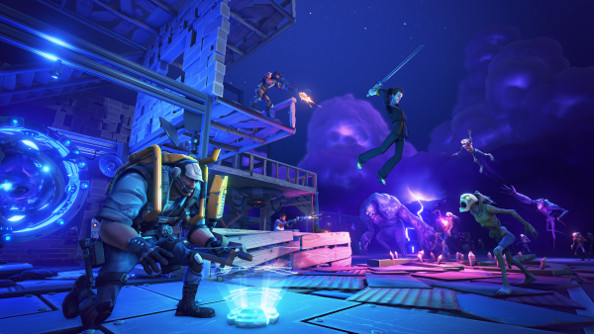
This is the one part of the game where you can really feel that you’re playing an Epic game. Movement and shooting controls have a perfect sense of weight and precision. For all the cartoony whimsy on display in Fortnite, it feels like a first-rate horde mode shooter once the bullets and bombs start to fly.
“Horde was an influence, even for me when I started,” Sugg admitted, “I liked that mode in Gears, and Gears 3 took it to a different level from Gears 2, but even that wasn’t as open and free form as what’s in Fortnite’s toolkit. …We wanted to make the experience where players feel awesome about interacting with the building system.”
I found it enjoyably hectic. Unless you’ve really stocked up for battle, the enemies will eventually wear out your traps and consume most of your ammo. Walls will start to crumble. The opening stages of a battle are pure slaughter as you use the best tools you have available, but the later stages are nothing but chaotic firefighting as you scrounge for ammo, recover materials, and patch up you fort in the middle of combat.
Multiplayer shaming
More than anything else I saw, multiplayer was a work in progress. This is also my defense for what has to rank as the most embarrassing multiplayer performance of my life.
Multiplayer involves both battling against another team and against monsters. The team with the last fort still standing is the winner. Where it gets really tricky is balancing all those priorities from the single player into an ongoing battle. You have to be gathering resources and building up your fort while also denying your rivals their own chance to scavenge. You have to defend your fort but also go attack the enemy’s fort. With teams of just four people, this was a pretty tall order.
Two classes really reigned supreme in this mode. The ninjas, with their speed and high damage, were great for running in and cutting down the opposition, while the engineer stayed home and added more defenses to the fort. The soldier, my chosen class, was a bit weak by comparison. I was warned that they were a touch out of balance.
Let that be exhibit B in my defense.
I never really could grok the pacing of multiplayer. It was a little bit too whack-a-mole for my liking, and I couldn’t escape the feeling that I was always in the wrong place at the wrong time. If I was out scavenging, our base was getting torn apart. If I was defending, then the enemy was just building up their base to become an impregnable castle.
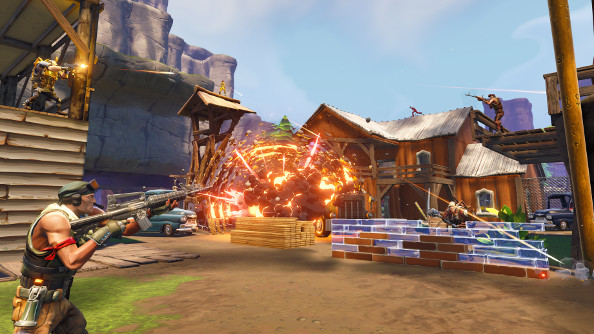
Which is all by way of saying my team went 0-4 and never even got the enemy’s base down to 50% health. But I wasn’t sure I was the problem until I had to duck out of a losing game in order to make a phone call. We were down to about 5% health and the enemy was at 80%, so it seemed like it was a done deal.
I walked out to the Epic lobby, past the giant, two-stories tall Unreal Tournament soldier, and walked in irregular ellipses until I found a signal. After about ten minutes, I came back downstairs and one of my teammates turned to me with a big smile, “Heeeey, you missed it! We won!”
Let’s be clear, I didn’t miss anything. My absence caused my team’s tremendous comeback victory, which means that Fortnite is not even out yet and I might already be a failure at it.
Under construction
Darren Sugg consoled me afterwards, saying — at least five times — that the balance isn’t right. I would bet you this is something that’s in a PR handbook somewhere. Chapter 5: When a Game Writer Sucks at Your Game. I would not have been surprised if he’d whipped a participation ribbon out of his pocket.
But there really is a lot still up in the air with Fortnite. As you might expect from a game arising from a game jam, Epic have been kind of making things up as they go along. The plan right now is for Fortnite to be a free game with some kind of microtransactions to fund it, but this is subject to tweaking. The multiplayer mode is really more of a “proof of concept” than what they intend to include in the game.
Still, I’d have to describe my time with Fortnite as being delightful. Even when my team got frustrated with a level and started building literal stairways to heaven and castles in the air, it was a wonderful sandbox. That part of me that dug trenches in my backyard is delighted that I can finally build the heavily defended killing grounds I always wanted. And I don’t even need a shovel.
